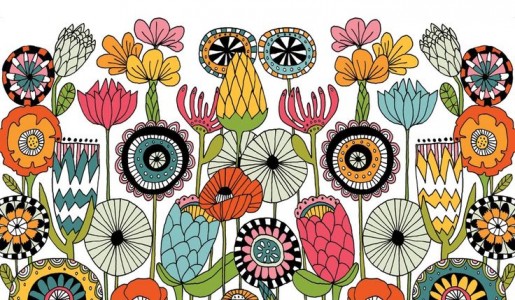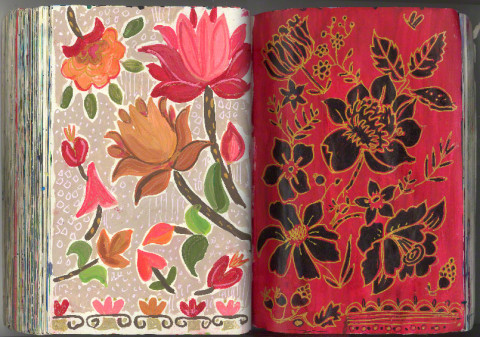Posts Tagged ‘art journals’
1.

The Round 1 Cybils Award panels have made their selections, and finalists will be announced on Jan. 1st. My YA Fiction team read a total of 140 books (more if you count one or two titles we wound up shifting to YA Speculative Fiction). I finished with a personal tally of 63 novels read. Sixty-three! My eyes is tired. 🙂
I’ve fallen way behind on updating my Goodreads and the book log here on my site. Hope to catch up this week.

This page, which includes Cybils and non-Cybils reads, is about thirty books behind. Yikes.
2.
My reward for finishing Cybils round 1 was setting up my calendars for 2017. I had to laugh when I realized that everything on my Christmas and birthday lists this year was a calendar of some sort. The Lisa Congdon wall calendar for my desk area; a Japanese woodblock print calendar for the living room (Rilla and I are obsessed with Hokusai lately); a 2017 Hobonichi Weeks to be my carry-with-me appointment book; and (swoon) new seasonal inserts and planner embellishments for my Wild Simplicity Daybook (which arrived as a gift from my treasured friend, Lesley). Anyway, I have started the task of entering upcoming events and work deadlines into my planner and appointment book, and I’m enjoying setting up my Daybook for a new season of high tide. (I use the Daybook to record our homeschooling adventures. It makes a truly gorgeous chronicle, and even more so this year with the earth-friendly “stickers”—lovely bits of artwork to cut out and paste in).
It’s a rare overcast morning here, so I’ll have to wait until later to catch photos of everything. Bit of a tease to post about plannery things without pictures, but what can you do?
3.
A new year means new sketchbook plans. I was delighted to see that Lisa Congdon is offering a new class at Creativebug: the Creative Boot Camp. Rilla and I will be spending our Saturday nights this way for the next six weeks.
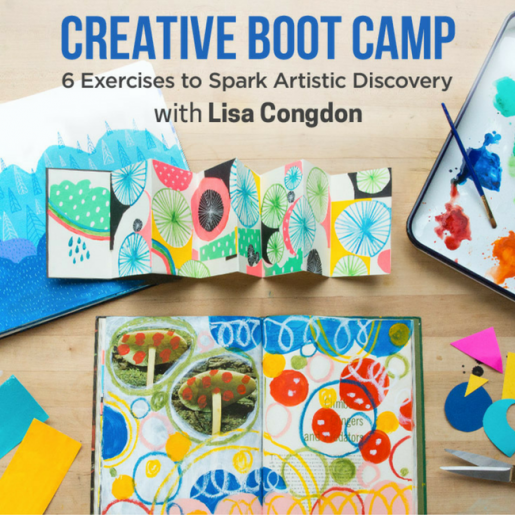
(Note: that’s an affiliate link. Creativebug was offering a holiday special of a $15 Amazon card with purchase of a gift subscription—as far as I can tell, this appears to be still going on. As I’ve mentioned before, I consider our $4.95/month Creativebug subscription to be one of the absolute best expenses in our homeschooling budget. Unlimited arts and craft classes, beautifully presented.)
4.
I should have titled this post “what I’m busy with this week besides work.” The assignment crunch that kept my blogging sparse during the past two months will continue through January and beyond. But it’s all good stuff. I winced, though, when my friend Jenn mentioned that she’d seen so little of me here and on social media that she wondered if I’d given up the internet altogether. Not by choice, that’s for sure! I’m trying to work out a short daily formula of sorts that I could apply to revitalize Bonny Glen in the new year. The old listography daily happy lists, or Instagram-style with a photo and notes, maybe. And a return to my Booknotes of yore. I miss them! And after the Cybils finalists are announced on Sunday, I’ll have lots of YA novels to talk about…
5.
What are you busy with right now?
December 16, 2016 @ 5:15 pm | Filed under:
Art 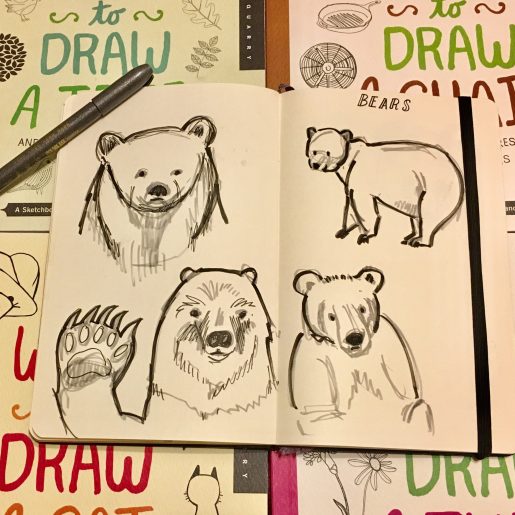
In a comment on yesterday’s “inside my pen case” post, Hanni wrote:
I have loved watching your journey of learning to sketch and draw. I want to start myself but I’m nervous. Have you always been a person who doodled etc? Or did it start when you made it a goal to sketch everyday? Seeing if there is hope for a person like me who has never done it naturally but has always been inspired by others.
I answered with a long reply, which I’ve decided to pull into its own post here. Tl:dr version: If I can do it, anyone can.
Hanni, start, start!!! I wasn’t a doodler before…I used to try to draw as a kid and was always so frustrated by my inability to make anything look the way I wanted it to. In college I took a costume design course that included a brief unit on Drawing on the Right Side of the Brain. That book blew me away. And in doing those exercises in class, I was astonished at how much better I got, and how rapidly. But then I dropped it again…for over 20 years.
I started this daily practice with Lisa Congdon’s line drawing class at Creativebug in fall 2014. From there I jumped to Sketchbook Skool and was really inspired and energized by those classes. Or—I guess actually I started with a Creativebug class on art journaling with Dawn DeVries Sokol* before the Congdon line drawing class, and I liked that one but found that what I really wanted was to learn to draw (vs art journaling which I always admire when I see other people’s but don’t seem drawn to in my own practice).
Since then, Creativebug has added SO MANY great drawing classes (all for your $5/mo subscription). I especially like the ones that are Daily Drawing Challenges because they walk you through how to draw specific things. (I’m currently obsessed with spatulas. Don’t ask me why. Just something really satisfying about that shape, LOL.)
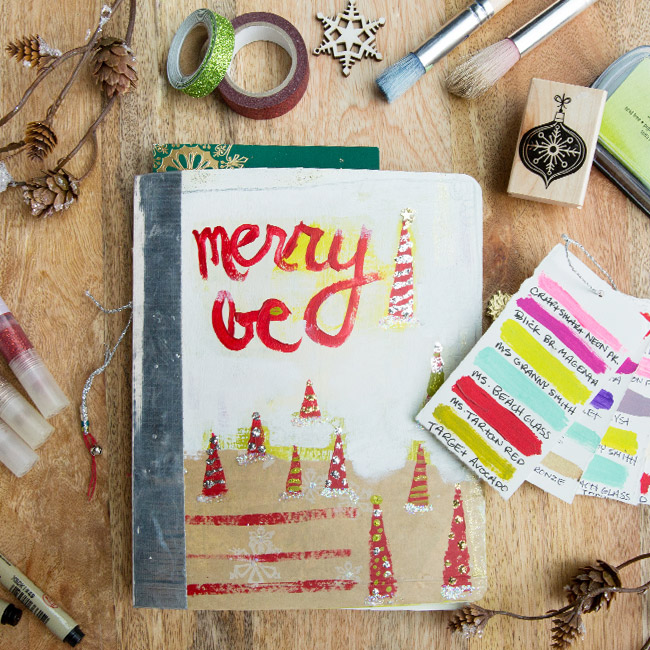
*Dawn Sokol has a new Holiday Art Journaling class at Creativebug that Rilla and I will be checking out on our next art date, because art journals are absolutely my daughter’s cup of tea. (Affiliate link.)
For dipping your toes in without spending money, I would recommend trying out some of Koosje Koene’s free “Draw Tip Tuesday” videos on Youtube. So good and totally doable. Search YT for them and then maybe scroll back to some earlier ones and work forward. You’ll see that a lot of the stuff in my sketchbook comes from Koosje’s lessons.
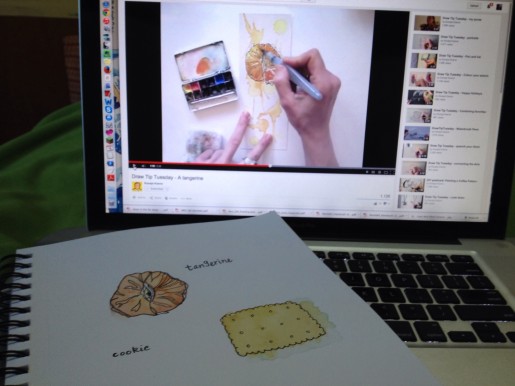
Other good online instructors are:
Jane LaFazio, Liz Steel, and Roz Stendahl. I encountered them all via Sketchbook Skool first. Then Jane came to San Diego for a one-day workshop version of the nature journaling/watercoloring class she offers online, so I signed up for that. And oh my! So awesome. Here’s a post with some photos of the work I did in that class.
Liz and Roz are both gifted instructors. Their online classes are video-based and include extremely detailed PDF handouts to download.
Backing up to your question: Honestly, I don’t have natural drawing talent. I think in words, not pictures, and I can’t just sit down and draw something out of my head and have the angles and shapes look right. I’m frustrated a LOT of the time by my shortcomings. But natural drawing talent isn’t required to be able to *learn* to draw. If you can sign your name, you can already make all the basic shapes that every single drawing is composed of. That was one of the Drawing on the Right Side of the Brain revelations that floored me, way back when. Anyone can learn.
Danny Gregory (the other co-founder of Sketchbook Skool along with Koosje) makes a distinction between small-a art (which we can all make) and capital-A Art (you know, museum stuff). 😉 I’m not striving for Art, just art. My sketchbook journey has made me really happy. About every ten pages I draw something I actually like. 🙂 And you know what, for now that’s plenty. I usually mess up the page with something else, but sketching is something I do that truly is about process, not product. The pens and paints feel so good in my hand. Mark-making, color-swirling—it’s incredibly satisfying.
And I like having this thing I do that is purely about personal satisfaction. Writing is the Thing I have always done, the Thing that defines me—and because I’m good at it, it’s the Thing I do for a living. Which…puts you in a different relationship with the Thing. If that makes sense. Sketching owes me nothing, and I owe it nothing. No demands beyond the easy five-minutes-a-day minimum I impose upon myself. Most days, it’s much more than that, because once I get sucked in, I never want to start.
I often yearn for a better eye, a stronger and more original sense of artistic vision in my work (like the brilliant creative vision I see manifested in the work of the sketchbook artists I admire on Instagram), and as I said I get plenty frustrated with my fumbling, my un-originality. But that’s all before and after the fact. DURING, when the pen is in my hand, all of that drops away and I experience the pure, absorbed joy of mark-making. That’s what keeps me at it, not a sense of progress (although when I look back, I can see that I have improved).
I hope you’ll dive in! Let me know if you wind up taking any classes…

A last thought. When I began taking online classes, I found that many instructors speak very strongly against sketching in pencil, on the grounds that it makes beginners too fussy, too prone to erase. I will say that while I understand that thinking (and do a fair amount of sketching directly in ink myself, because I’m addicted to pens), for me that advice was a misdirect. I spent about eighteen months obediently eschewing pencil before I had a light bulb moment of: oh wait, I love how pencil feels going on the page. And boom, just like that, things opened wide. I love pencil sketching and then putting ink over it. That suits me really well. Diminished a lot of my frustration over ‘ruining’ things because it takes me a few tries to get the shape right. And I just plain like the texture! It’s funny that with everything else in life (homeschooling, ahem) my entire approach is: take what works and do my own thing with it, but with drawing I was quite cowed by authority at first.
I’ll close with some books Rilla and I have enjoyed working from, these past two years. When I’m stumped for material, I pull out one of them and tackle a page.
20 Ways to Draw a Tulip and 44 Other Fabulous Flowers
20 Ways to Draw a Cat and 44 Other Awesome Animals
20 Ways to Draw a Tree and 44 Other Nifty Things from Nature
20 Ways to Draw a Chair and 44 Other Interesting Everyday Things
Illustration School: Let’s Draw Cute Animals
Illustration School: Let’s Draw Happy People
Illustration School: Let’s Draw Plants and Small Creatures
















Practical inspiration from Danny Gregory:
Art Before Breakfast: A Zillion Ways to be More Creative No Matter How Busy You Are
The Creative License: Giving Yourself Permission to Be the Artist You Truly Are




Rilla and I are looking forward to working through this book together: Draw Every Day, Draw Every Way (Guided Sketchbook): Sketch, Paint, and Doodle Through One Creative Year by Jennifer Orkin Lewis (AugustWren on Instagram—my fave!). This is one of those books you’re meant to and paint directly in, and I’m excited to think we’ll be creating a little archive for ourselves of our shared sketchbook journey. She’s been my staunch companion every step of the way, so far. Danny and Koosje and Roz are the superstars of Rilla’s world.


(Jennifer Lewis also offers a wonderful course on painting with gouache at Creativebug, as well as a Daily Painting Challenge. I’m making slow progress through both, because gouache takes a bit more planning for me than just reaching for my watercolor palette, but these are marvelous classes.)
Related posts:
• Daily Creativebug Challenge
• Drawing It Out (2005 post that, like this one, reminisces about that costume design class and the Edwards book, but then focuses on the how-to-draw books my older kids loved in those days. It’s funny to reread it now and see that despite its “anyone can learn to draw” message, I wasn’t striving in that direction at all myself. I talk about being able to draw a tree, a cartoon giraffe, and an alligator. That was the full extent of my doodling repertoire at the time and in this post, I don’t seem to express any intention to move beyond that. I’m sure it’s no coincidence that at the time it was written, I’d had four babies in ten years and was expecting a fifth.)
• Notebooks and sketchbooks and planners, oh my!
• 2015, Year of Paper
• Planner Love
• Notebookery
• Unearthed: the Notebooks
• Ten Ways to Cultivate a Family Art Habit
• My interview with Danny Gregory about raising creative kids
• Learning in Public
August 5, 2016 @ 4:00 pm | Filed under:
Art August Daily Drawing Challenge: 31 Art Journal Prompts with Dawn Sokol at CreativeBug. Dawn’s Art Journaling class was what kickstarted my daily sketching habit two years ago this month. (!) This “31 Prompts” is a new class that looks like a good time. A CreativeBug subscription is $4.95/month, which I think is a pretty great deal for the huge array of courses that gives you access to. Rilla, Beanie, and I manage to wring every penny and then some out of our subscription.
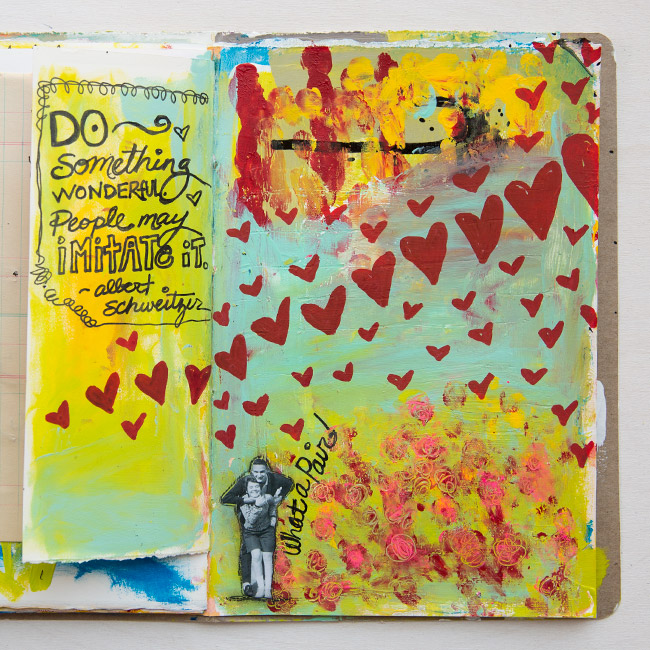
(Affiliate link, but I’m also a happy subscriber. I recently took and quite enjoyed Intuitive Painting with Flora Bowley. Other favorites are Creative Doodling with Pam Garrison, Daily Painting Challenge with Augustwren who happens to be one of my favorite Instagrammers, and anything taught by Lisa Congdon.)
***
Creative Lettering with Andrea Joseph at Sketchbook Skool. Andrea’s week in Sketchbook Skool’s Seeing “kourse” is one of my three favorite sets of lessons in the entire SBS lineup. I love, love, love her art and her mellow approach to teaching. And the way her sketchbook pages are an interplay of words and images is tremendously appealing to me. I also really resonated with a comment she made in one of her zines about how she has always had several “handwritings”—me too! Me too! I never could commit to a single style of R or F. So the idea of a whole course devoted to this subject has me pretty giddy, I must say.
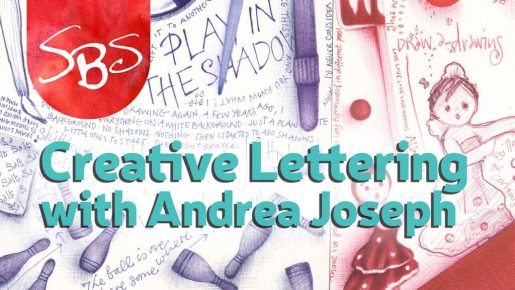
(Not an affiliate—just a huge fan of Andrea Joseph and Sketchbook Skool!)
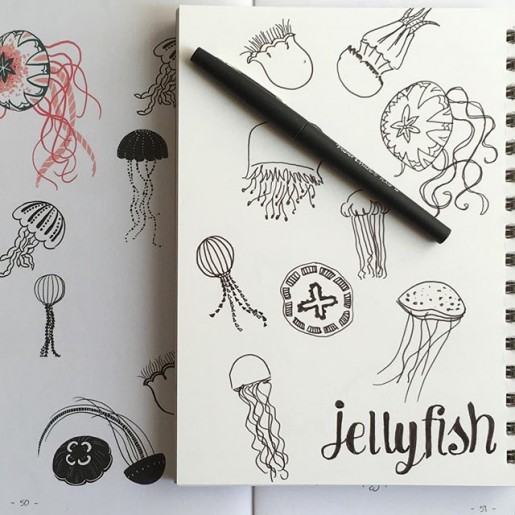
It started, I think, with my commitment to a daily sketching habit in the fall of 2014. By last January, the habit was firmly established, and I only missed a handful of days all year. January is also when I started taking “kourses” at Sketchbook Skool—which exposed me to not just the lessons and work of accomplished artists, but also to their media of choice. Which is to say: they have firm opinions about pens, making them my kind of people.
Putting pen to paper in my sketchbook reminded me how much I love that feeling. Now, I have never enjoyed doing large amounts of handwriting—I can’t write my books longhand, for example. My wrist aches after a couple of pages. But I love penmanship: other people’s, mainly. My handwriting is changeable and seldom neat. I never managed to commit to one way of shaping letters, so I wind up with different kinds of I and r and k all in one line. Last night I was numbering pages in a new bullet journal and realized that some of my 4s were the pointy kind and some were not. Happens all the time. I like change, y’all.

Anyway—I can’t write volumes by hand all at once, but I adore the feeling of a good pen on the right kind of paper. Experimenting with various pens (Pigma Micron, Le Pen, Pilot Metropolitan, Lamy Joy with 1.1 nib) reminded me how much I love analogue notetaking. So while I still find apps like Workflowy useful for tracking particular kinds of tasks, in the past few months I have shifted almost entirely to written notekeeping.
Notes on paper
Bullet journaling works very well for me. I’ve always kept a notebook as an idea and memory catch-all: phone call records, tasks completed, shopping lists, story ideas, doodles—it all winds up in the notebook in a giant jumble. Adding a bullet-journal-style index and page numbers was a revelation: now I can have my hodgepodge but find things later. Perfect.
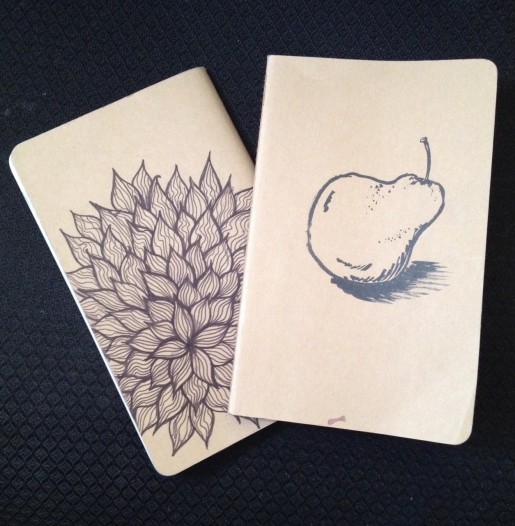
For the first part of this year I used kraft-brown Moleskine Cahiers. They’re just the right size for tucking in my bag, they’re sturdy enough to handle the beating I give them, and they fill up in a month or two which means the continual fresh start I love. Then, in August, a glorious friend surprised me with a Midori Traveler’s Notebook. It was love at first sniff. I mean, I. JUST. ADORE. THIS. THING.
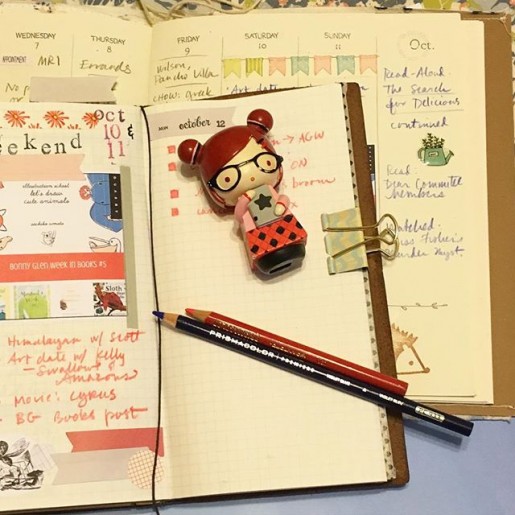
A traveler’s notebook, if you don’t know, involves a cover (usually leather, sometimes cloth or vinyl) that has a sturdy elastic cord or two strung through the spine. You slip a paper notebook under the cord to hold it in place. Then you can use additional bands to hold other inserts—various types of notebooks, folders, calendars, even plastic credit-card sleeves or zipper pouches.
My Midori set-up
After playing with my Midori for a month or two, I settled into the configuration that works best for me: a weekly calendar insert, a grid notebook, and a kraft folder that holds stickers, postage stamps, notepaper, and such. I keep a monthly calendar, too, but I don’t need to carry the whole year around with me so I have begun photocopying (and shrinking a bit) the current month and clipping that to my weekly page.
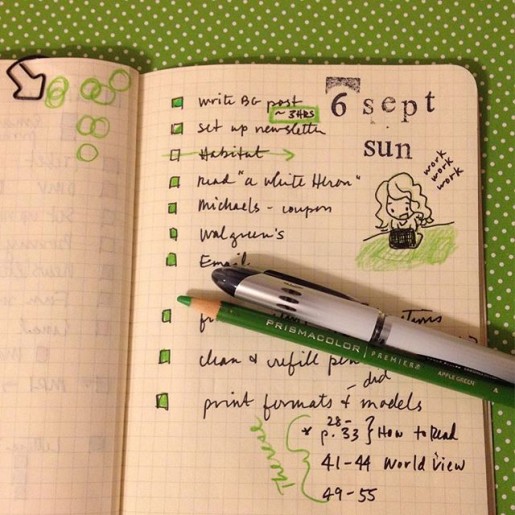
The blank grid insert is my bullet journal/idea repository/casual sketchbook, replacing the Moleskine Cahier. I number the pages and use the first page as an index, just as before. I like big fat checkboxes for my task lists, which I fill in with Prismacolor pencil as tasks are completed. Color is my happy place. 🙂 I also like to paste in ephemera and sometimes embellish with stamps, doodles, or washi tape. Basically, these inserts become collages of all the things that occupy my days and my mind. I seem to do a fair amount of sketching in them, too, even though I have an actual sketchbook for that purpose—I work in the real sketchbook daily but the TN grid insert is a low-pressure place to experiment, and I always have it with me.
Thanks to Lesley Austin’s beautiful Wild Simplicity Daybook designs, I discovered that a week-on-two-pages spread is an excellent space for me to do some chronicling. I’ve posted before about how I use the Daybook for recording homeschooling and housekeeping notes. I really like having a separate space (and such a beautiful one) for those things. I wear so many hats, and I need ways to keep my roles sorted. The Daybook (visible under my Midori in a photo above), like all of Lesley’s paper goods, conveys a sense of peace and serenity, and so it has become a really nourishing space for me to jot down my notes about what the kids read, did, said. I always feel so happy when I open that book.
Taking a cue from that experience, I decided to try the Midori week-on-two-pages for my TN. The version I selected (Refill #19) has the week in seven horizontal boxes on the left page, and a grid page for notes on the right. I use Google Calendar for our family appointments and schedules, so a couple of times a week I open G-Cal and add any new appointments to the Midori insert. At the end of each day, I create an entry on the weekly calendar page, filling it with notes about what happened that day. It isn’t a to-do list, it’s more like a diary. Not what needs to be done (that’s what the bullet journal is for), but what I actually did. The facing page fills up with quotes, ephemera, drawings, and notes on things I’ve read or watched.
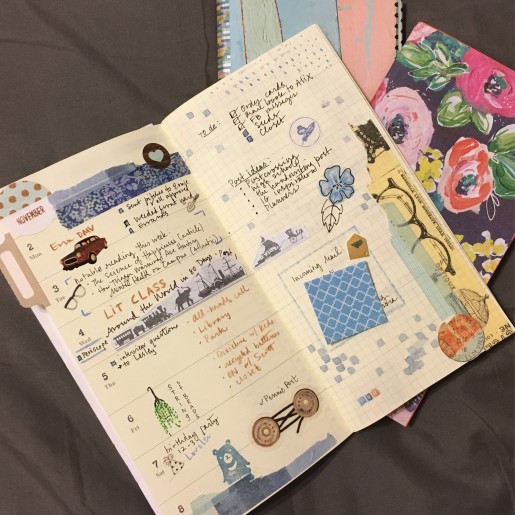
Since these pages serve as a kind of journal, I like to decorate them with washi, drawings, and watercolors. I wind up doing the ornamenting mostly on weekends. Often, I’ll start the week with two or three colors of washi in front of me, and that will set the tone for my week. This daily decorating is relaxing, it takes only moments, and I enjoy paging back through previous weeks.
So those are the two main TN inserts I carry around: the weekly calendar for journaling (more or less), and the grid notebook (Refill #2) for everything else. Those two inserts plus the kraft folder (Refill #20) make the Midori as fat as I like it to get. I could easily come up with uses for half a dozen more inserts (the TN’s capacity for letting you compartmentalize is its genius), but I found that I really prefer a non-chunky Midori.
However! I did decide to devote a single insert to all medical and health-insurance-related notes, and this has been one of my best moves ever. Instead of having those notes intermingled with everything else, they live in their own space now, with a list of phone numbers on the first page. I can tuck THAT insert into the Midori when we’re heading to an appointment. It’s perfect.
NEED MOAR PAPER
All this notebooking served to increase the satisfaction I was finding in putting pen to paper. And I found I was thinking about handwriting a lot. My little goddaughter sent me a thank-you note, and her mother’s handwriting on the envelope—the gorgeous, familiar handwriting that graced pages and pages of letters in the years after college when Krissy and I wrote to each other constantly—gave me a little jolt of joy and nostalgia. I hadn’t seen her writing in a while, and I missed it. I told her (via text, naturally) how happy I’d been to see her writing, and she said the same thing had happened to her when she saw my writing on the package I’d sent her daughter.
Shortly after that, I read that Atlantic article that was making the rounds about how the ballpoint pen killed cursive. Fascinating stuff, but the bit that grabbed me was this: “In his history of handwriting, The Missing Ink, the author Philip Hensher recalls the moment he realized that he had no idea what his good friend’s handwriting looked like. ‘It never struck me as strange before… We could have gone on like this forever, hardly noticing that we had no need of handwriting anymore.'”
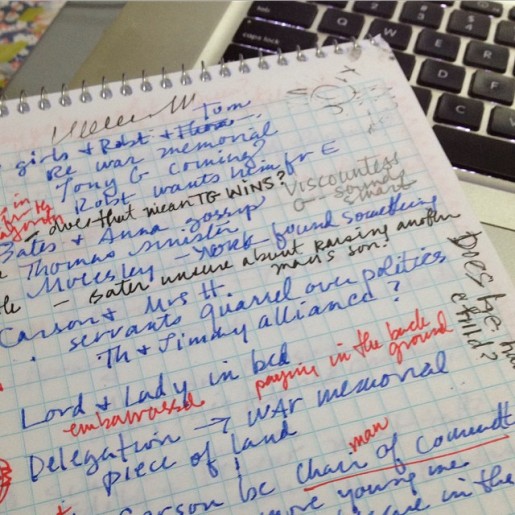
He had no idea what his good friend’s handwriting looked like. I miss handwriting, I thought. The distinct and beloved scripts of my old friends flashed before my eyes. I’d know those hands anywhere, could pick them out of any penmanship lineup. My kids probably won’t experience that. Jane has friends on the other side of the country she talks to via electronic means every single day, but they probably don’t know each other’s handwriting. I have plenty of friends myself whose writing I’ve never seen. If we met after 1995, chances are I’ve seen your handwriting seldom or never. (Tanita! What’s your writing like?)
Channeling my inner Jane Austen
The handwriting epiphany spurred me to the next phase of my analogue journey: I started writing letters again. Like, by hand. I have penpals in Denmark, France, Austria, and England, as well as various friends across the U.S.
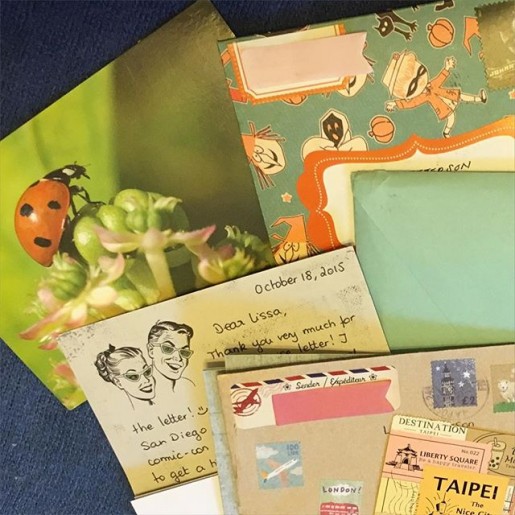
I’m amused and a little baffled that for so many years I thought of letters owing replies as a kind of guilt-ridden chore—I always took forever to answer, always had them nagging in the back of my mind. Because the truth is: snail mail is the cheapest fun around. Sure, they’re slower to write than email; slower to arrive than a Facebook message. But that’s part of the charm: the slowing down, the taking time. Just as many of us have (re)discovered the joys of slow reading in the past couple of years, I have found satisfaction in…what to call it? Not slow writing, really, because part of the point is that instead of waiting months or even (gulp) years to answer a letter, I now try to reply within three weeks; I guess what I’m enjoying isn’t about speed (or lack of it) after all. It’s about a tactile experience. The skritch of a fountain pen on flecked paper. The careful selection of stamps. The smoothing-out of a bit of washi tape across a seal. The rustle of envelopes as they slide into the box, slumbering before their journey to places I’ll never go.
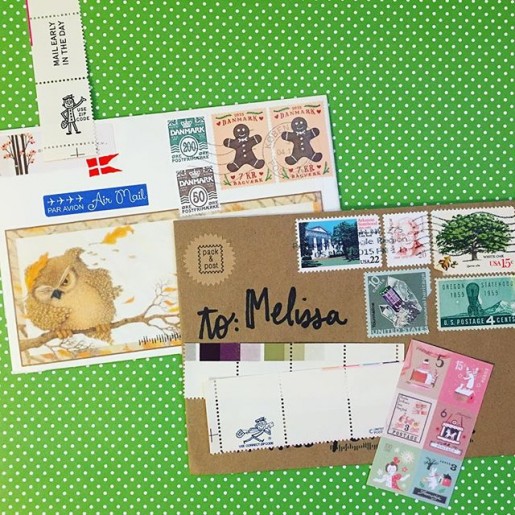
And best of all: the incoming letters. Foreign stamps, unfamiliar scripts, universal experiences. Beautifully decorated, many of them—it’s like getting mail from Griffin and Sabine. This one written at a café in Vienna; that one at a Starbucks in Portland. Kaleidoscopic glimpses of a life gradually resolving into a picture. We talk about things we could easily tell via email, but we’ve decided to let these stories take the scenic route. Some of them never arrive, or show up months later, ragged and stained. This only makes us love them more.
I’m writing to say I’ll write soon
A piece of the experience that affords me much merriment is the impulse, whenever a letter arrives, to hurry to Facebook and ping the friend who sent it. “Got your letter! Will reply soon,” I’ll write, and “Yay, can’t wait!” she’ll ping back. Never mind that the letter asks questions which could be more immediately answered via any of a dozen digital platforms. The answers will keep. Come Saturday afternoon, I’ll settle in with my cocoa, my envelopes, my wonderful new pink Lamy Safari that I got for my birthday. Which paper—the whimsical or the lovely? The fern stamps, or the Ingrid Bergmans? I’m almost out of globals, and the post office won’t have the new ones for a while. But have you seen them, the moons? I’m already imagining them on dark blue envelopes…
Our digital and analogue worlds will forever be intertwined, I believe. We’ll snap photos of our beautiful incoming mail to share on Instagram, hashtagged so our kindred spirits can find and enjoy it. We’ll trade addresses on Facebook. We’ll email to find out if that letter ever arrived. We’ll scour Etsy for traveler’s notebook inserts and stock up on ink at Goulet Pens. We’ll sign up for swaps on websites, and then anxiously check tracking to see when packages might arrive. We’ll reblog Tumblr articles about clever ways to hack a bullet journal. We’ll watch Youtube videos about how to set up a Midori and we’ll tap the heart button a zillion times during an unboxing on Periscope. We’ll link to photos of new USPS stamp releases in our blog posts. 😉
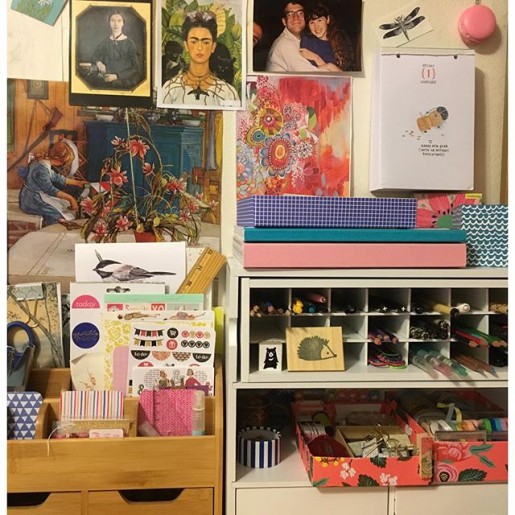
My blog, though, is perhaps the thing that suffered this past year as my attention shifted to paper and ink. I found that when I had a few quiet moments, I was more apt to want to spend them sketching or writing a letter than blogging. After ten years of a steady blog habit, that was a bit of a surprise. In January, this blog will be eleven years old. I’ve successfully figured out how to integrate my analogue and digital calendar-keeping and task-tracking, but it did take a little while for the pieces to settle into place. I expect the same will happen with blogging.
Happy New Year, friends!
On my mind constantly of late: notebooks, sketchbooks, art journals, and combinations thereof. Conversations are swirling in several of my circles—
• at Sketchbook Skool there is always lots of chatter about what people prefer to draw on and with;
• over at Wisteria & Sunshine, Lesley has been revisiting the topic of daybooks (especially handmade ones);
• Kortney is posting wonderfully enticing things about right-brain planning;
• Amy Ludwig Vanderwater is hosting a summer “Sharing Our Notebooks” project that I plan to participate in, soon as I get a chance…
Once a week I meet a small group of teenaged girls (one of them my Beanie) at a coffee shop to discuss literature while their younger siblings take piano lessons in the studio upstairs. This is hands-down one of the best hours of my week: meaty stories; lively analysis; word-collection; chitchat. A couple of weeks ago we ran off on a tangent of comparing one another’s notebooks. The conversation coincided with a similar thread at Wisteria & Sunshine, so I was primed. I’ve been using graph-style spiral-bound steno pads for the past year or so, with a modified bullet-journal method. (Chiefly the use of an index page at the front of each notebook—that was a game-changer for me.) But I was hankering after something less utilitarian-looking, and one of my lit girls had a new kraft-brown Moleskine that set me swooning. Back at home, I looked it up and it was exactly what I wanted. Slim paperback in the size I favor (Moleskine calls it “large” but it’s only 5×8), and—this was crucial—they offer a “squared” (graph-style) version.
I’ve used Moleskines before but mostly the Volant model with the bright solid-colored covers. So pretty on my shelf but you can’t really fold them back on themselves, and I don’t like writing on a double-page spread. That’s why I’ve mostly sighed and made do with spirals. But Moleskine’s Cahier model with a heavy paper cover is flexible enough for me to fold back. And I love the pocket in the back, such a nice touch.
Kraft paper is one of my favorite surfaces for decorating, so of course the cover cried out for some decoration. I started on the back in case I messed up. Still haven’t decided what I want to do on the front.
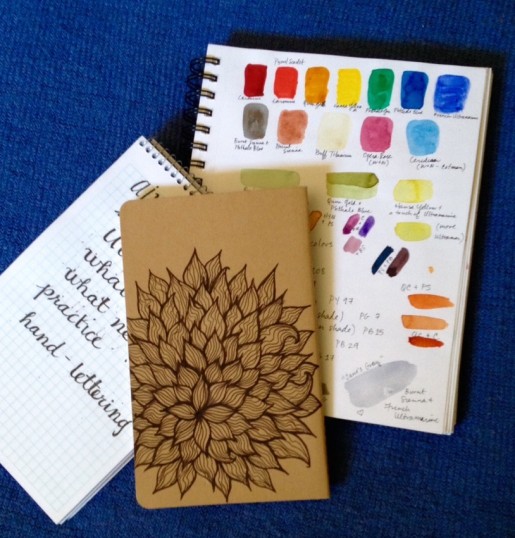
gridded steno notebook, kraft brown Moleskine Cahier journal, Canson Mixed Media Sketchbook
I love a skinny notebook not only because it fits easily in my bag, but because it fills up faster. I am mad for the fresh start. I had a few pages left in my May steno book but I craved a clean slate for June, so I’ve been using up the steno pages with hand-lettering practice.
I use my daily notebook for list-making, idea-sorting, story-outlining, note-taking…basically anything that involves words. Words + doodles, really: my “work” pages are always margined with crosshatching and basketweave and spirals and mushrooms…whatever. I used to try to keep things compartmentalized: one notebook for current book-in-progress; one for medical & insurance notes (I always seem to have volumes of these); one for quotes/commonplace book entries; one for to-do lists…but they always wound up melded together, and then I’d have three or four mishmash notebooks going at once, which was ridiculous. So I gave up and embraced my brain’s clear need to dump itself onto a page, melting-pot style, and now I let all those channels of thought intermingle. (Messily, much like the mingling of metaphors in that sentence.)
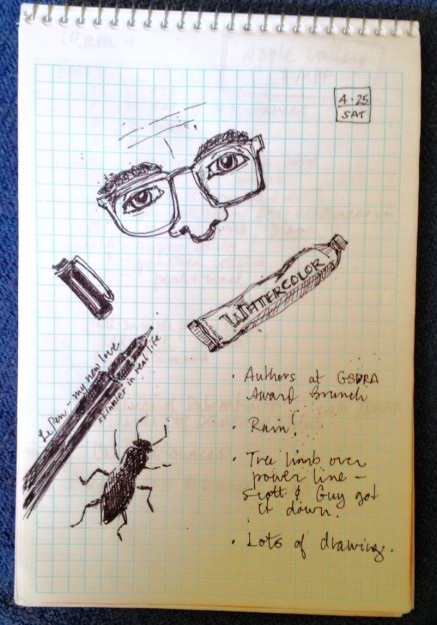
And these days my word-notebooks are overrun with drawings, too. I have a separate sketchbook—two, actually; a smaller (5×8) hardcover Moleskine that fits in my bag, and a larger (7×10) Canson mixed-media sketchbook that is my place to experiment with drawing techniques and paint. That’s where I do my Sketchbook Skool assignments—it’s my it’s okay to screw up place. Consequently, it sees way more action than the Moleskine sketchbook, which I pretty much only use when I’m 1) away from home and 2) feeling unobtrusive enough to draw in public. I don’t mind kids looking over my shoulder but I’m way too shy about my work to want adults eyeballing it in progress.
Interestingly, the Canson Mixed Media Sketchbook is the one that got a thumbs-down from Roz Stendahl (THE source of in-the-field info on all things art supply), and when I read her review I had a major light-bulb moment: Ohhhh, so you mean the paper isn’t supposed to buckle when I paint? This Canson (I’m in my second one now) is the only sketchbook I’ve ever painted in, so I thought that’s just how it went, unless you bought one with watercolor paper. Roz’s report clued me in to the possibility that the book I picked (entirely because it was on sale at Michael’s) may not perform as satisfactorily as other brands. I’m nearing the end of this one (you guys!!! I’ve filled two whole sketchbooks with drawings!!) and may take Roz’s recommendation and try a Strathmore Journal Series’ Mixed Media book next time. Does Michael’s sell them, I wonder? Got another coupon burning a hole…
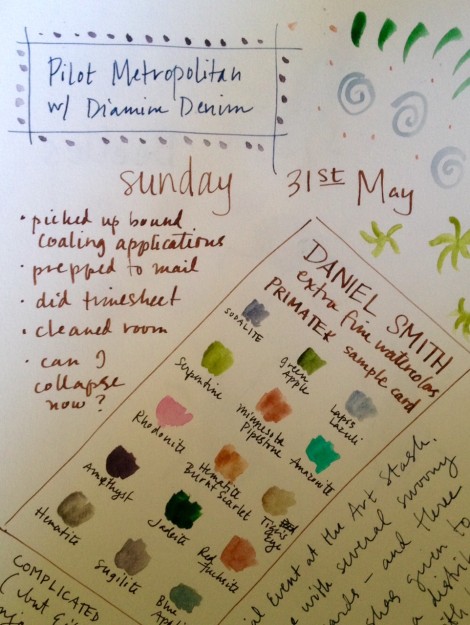
bad phone photo; can’t be bothered to scan
Okay, so I was saying that in theory I have the sketchbook(s) for, well, sketching, and the notebook for all the word things, but the truth is that ever since I started working on my drawing skills last fall, I’ve got rough sketches running wild all over my word-notebooks. Again, this is something I’ve just decided to be at peace with. So much of my work involves a rigorous process of polishing and structure, and I think perhaps my mind really needs a place to be messy and unfiltered, a place to set itself down in raw form. It’s like a test kitchen for my thoughts, I guess. This is where the index is so invaluable: it allows me to quickly locate the notes from that Very Important Phone Call without having to hunt through pages of nonsense. I try to update the index at least once a week—just a mild leaf-through to note down the page numbers on which I have recorded important information. I number the pages of my notebooks in the bottom right corner, about ten pages at a time. I like to write my to-do lists on a Post-It that can travel from page to page. As each task is crossed off, I jot it down in the notebook for a record of what I’ve done.
Since the ugly steno books all look the same on the shelf, I would run a highlighter down the sides of the pages, a different color for each new book. But so far the kraft Moleskine is serving beautifully, and I doubt I’ll go back to the steno grids. I might use a bit of Washi tape on the spine to differentiate the Moleskines on the shelf, once they’re filled.
***
Back to my coffee-shop girls. We had so much fun that day, comparing notebook preferences, that we decided to all bring our sketchbooks the following week. Which was truly delightful—what a treasure, this look at the outpouring of creativity from these girls. Beautiful design work (I mean really breathtaking, some of it), whimsical drawings (much more skilled than mine), and illustrated quotes, and just so much wonder, so much evidence of curious minds sifting the world. I felt really honored to have this work shared with me. We are nearing the end of the topics we charted for our class, but the girls begged me to keep going through the summer. So we’re thinking of spending a few weeks on sketching and notebooking. I have all sorts of ideas for things we can do together—heavily Lynda Barry-influenced, naturally, because who better to guide you through an exploration of all the things a sheet of paper can become?
February 16, 2015 @ 9:28 pm | Filed under:
Art 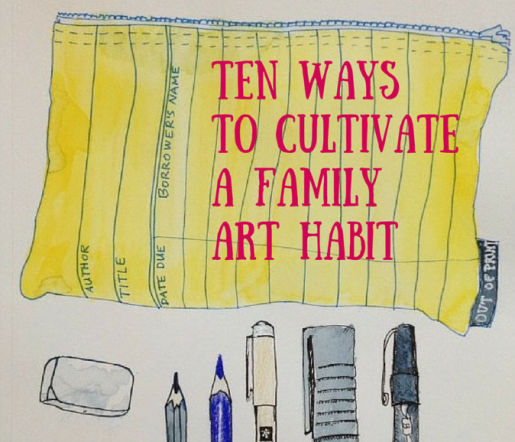
On Twitter, Kim asked if I had any advice for a family getting started with sketching and art journaling. Did I ever!
I’ve Storified the conversation, if you’d like to see how it unfolded, but I’ll recap it here as well.
My replies below, expanded a bit. Points #6 and 7 are the most important.

Suggestions? Yes, lots!
1) Koosje Koene’s Draw Tip Tuesday videos. She also offers classes in drawing and art journaling. (Here’s a post I wrote about her videos in November.)
2) Sign up for a free two-week trial at Creativebug and take Dawn Devries Sokol’s Art Journaling class and Lisa Congdon’s Basic Line Drawing. I wrote about how much Lisa’s class inspired me in my “Learning in Public” post.
3) A bunch of books to inspire you: Lynda Barry’s wonderful Syllabus; Danny Gregory’s new Art Before Breakfast (it’s a delight; I’ll be reviewing it soon) and the much-beloved The Creative License; the Illustration School series; the “20 Ways to Draw a…” series; Claire Walker Leslie’s Keeping a Nature Journal; the Usborne “I Can Draw” series. And a few more recommendations in this older post.
4) Maybe try a Sketchbook Skool course! They offer a free sample class (I mean klass) so you can get a taste of the magic.
5) Cathy Johnson videos. Rilla loves Cathy’s art and her gentle delivery.
6) The most important thing! Really just dive in and do it—if you do it, the kids will follow. Mine truly love to see me working & playing in my sketchbook. Actually, Rose was just commenting on it today, before this Twitter conversation occurred. She said she has really enjoyed watching me start from scratch (so to speak) and work at learning to draw. They all seem to love to see me trying, making mistakes, learning, improving. My progress excites them almost as much as it does me. 🙂
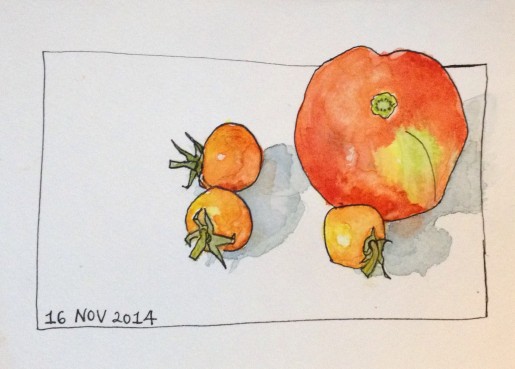
7) The REALLY most important piece of advice I can give: Allow plenty of TIME and room for mess. Many parents say “I want my kids to be creative” but can’t tolerate mess. Art is messy. Creativity is messy. You need space to leave work out and return to it. Supplies in easy reach. And big spans of time for messing around, staring into space, doodling, doing things that look unproductive. I can’t emphasize enough how important this is to any creative process. Time and room. (More on this in my post “Makers Gotta Mess.”)
When I’m writing a novel, my most intense work happens while I look like I’m doing nothing at all. Sitting and staring blankly, chewing my nails, or filling an entire page with tiny lines and spirals. This is my body getting out of the way so my brain can get down to the real work of creating.
And for the visual arts, these totally tactile pursuits, you’ve got to have a place to spread out your paints, your pencils, your small objects that make you itch to draw. You know what’s nice and tidy and doesn’t clutter a room? A cellphone. If you want them to spend less time staring at screens (I’m not knocking screens here, you know I love me some screen time), you’ve got to grant them some real estate.
With that in mind, I make a point of keeping art supplies in easy reach. We have a dedicated kitchen drawer for placemats, paper, paint supplies so even the youngest kids can help themselves. Jars of colored pencils & crayons on table, a sharpener on the kitchen counter, a stack of art books on the shelf nearby. I want them to have constant free access to art materials. It’s also a good idea to keep a bag packed for outings. I described ours in this old GeekMom post.
8) And what materials do I recommend? For littles: good paper, cheap paints. I elaborated on my reasons in this post from several years back:
When my older kids were little, I read lots and lots about the benefits of providing children with really high quality art supplies. In some cases, I still agree: Prismacolor colored pencils are worlds better than your drugstore variety. The lead is so creamy and blendable. They’re expensive but they last a long time—we’re on our second set of 72 colors in over ten years.
But watercolors? Real watercolor paper makes a huge difference, but it’s expensive; that’s one reason I was so taken with Jenn’s idea to cut it into smaller, postcard-sized pieces. But when it comes to the paints themselves, well, I’ve been the high-quality route, absorbed the persuasive literature that talks about rich pigments and translucent hues; bought the pricey tubes of red, yellow, blue; collected jars for mixing colors; watched my children squeeze out too much paint and gleefully swirl it into an expensive puddle of mud-colored glop.
Lesson learned. The 99 cent Roseart or Crayola sets work just fine. In fact, dare I say I think my preschoolers like them better? Mixing colors is fun, but there is nothing quite so appealing as that bright rainbow of pretty paint ovals all in a row. When Wonderboy and Rilla make a mess of their paints, Jane cleans them up with a rag and they’re practically good as new.
For older kids—and for yourself!—my advice is to skip the student-grade watercolors and go right to artist quality. More expensive but the difference is immense. You can use the money you saved buying cheap paints for the preschoolers. 😉
We’re still addicted to Prismacolor pencils—no other brand will do for me. And I like Micron pens for line drawing. The ink is waterfast so you can paint over it (like my pumpkins in yesterday’s post). I also picked up a few gel pens—white, silver, and gold—and Rilla has had unbelievable amounts of fun with them. I love the white one for writing on a dark surface, like on the tag of my pencil pouch here.
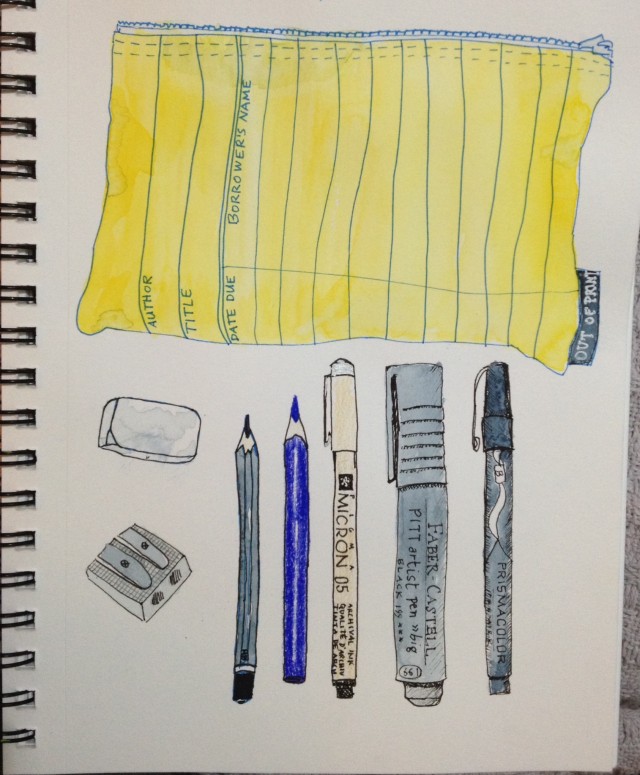
Don’t feel like you have to have millions of fancy supplies right off the bat. Look at what Andrea Joseph can do with a simple Bic pen. (Seriously, this blew my mind.)
The sketchbook I just filled up was a Canson Mixed Media, 7×10 spiral bound. The size worked really well for me and the paper takes watercolor okay (not perfectly but well enough for where I am right now). I also have a small Moleskine journal with watercolor paper, but it feels so special I find myself hesitant to use it and reaching for the mixed media book instead. (I’ve just started a new one, same as the one I filled up.) That’s my real playground, the place I’m not afraid to (in the words of my personal hero, Ms. Frizzle) “Take chances and make mistakes!” But I’m getting braver every day and the lovely paper in that Moleskine is calling to me.
I’ve also found I love doing my first rough sketches with a brown watercolor pencil, very lightly. I go over it with ink afterward and then, when I paint, the pencil just blends in and becomes shadow. I don’t sketch this way every time, but for some reason it seems to free me up. I’m more daring with this pencil. It takes me to a confident place between graphite pencil—with its sometimes overly tempting eraser—and straight-to-ink, which is sometimes exhilarating and sometimes terrifying. The brown Aquarelle feels like my co-conspirator. I don’t know how else to describe it. I have even starting making some first tentative stabs at portrait drawing, thanks to this pencil. (I tried a selfie-a-day project for a week. None of them looked much like me, but this attempt on day seven could maybe be a cousin?)
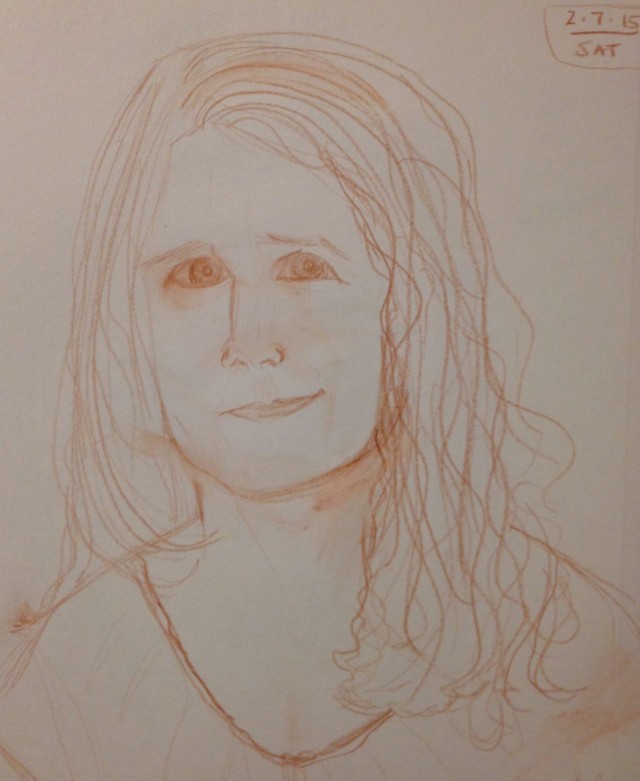
Guys, I still feel so shy about posting my drawings! I mean, I have so many friends who make their livings as illustrators—heck, one of them even just won the Caldecott! (GO DAN! SO THRILLED!) Do you know how nerve-wracking it is to know pros are looking at your rookie work? Of course you do. Because what I’ve learned is everyone feels that way. Even my most brilliant artist friends look at some other person’s work and sigh wistfully, wishing they’d made that piece. I’ve seen it happen time and again. So bit by bit I’m getting brave enough to share my baby steps.
9) Okay, so you have your lovely sketchbook and drawing implements, now what to draw?? Well, I guarantee Koosje Koene’s videos mentioned above will keep you and the kids busy for a good long while. There’s also this wonderful Everyday Matters Challenge list at Danny Gregory’s blog. 328 suggestions, so you’re just about good through 2016. And Kortney tipped me off to this most excellent Lynda Barry post (in Rilla’s words, I simply adore her) about keeping a visual diary.
10) And a last tidbit I almost forgot: A most beloved activity here (especially for Rilla and me) is to listen to audiobooks while sketching. Many of my happiest hours have been spent this way. We’re especially fond of Roald Dahl while drawing. Nobody brings on the whimsy like Dahl.

November 27, 2014 @ 10:29 am | Filed under:
Art “The habit of making art is wonderful. Sharing it is sublime.”
—Danny Gregory, artist, author of The Creative License and other wonderful books on illustrated sketchbook-keeping
November 24, 2014 @ 8:56 pm | Filed under:
Art 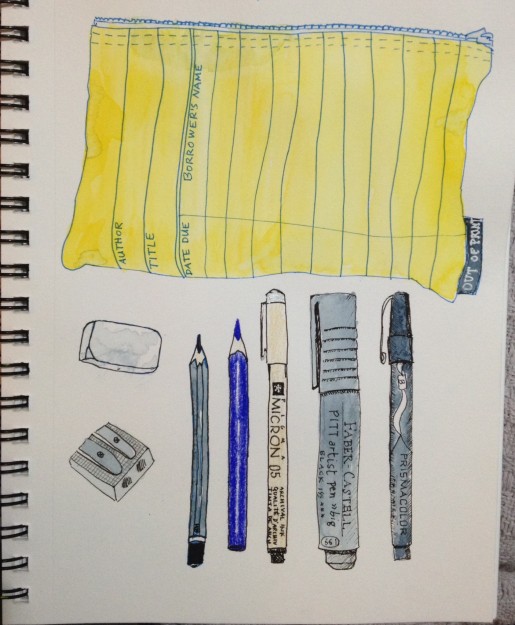
Something I think is wonderful about social media is the way so many creative people share their efforts and progress in various arts. I don’t just mean professional artists sharing their finished work, though of course that too is a great delight—this abundance of gorgeous, polished photography and painting and stories and poems and quilts and handwovens and other creations we find displayed all over the internet. Just Google artist sketchbook blog and you could be absorbed for weeks upon weeks.
But even more so, I appreciate the working-it-out pieces, the I’m-undertaking-something-new-and-here’s-how-it’s-going-so-far posts. Years ago, a bunch of us were doing this with quilting—posting pictures of our blocks, sometimes the first ones we’d ever made, crooked seams and all. You see it often with knitting and sewing and all kinds of handcrafts. Look what I made! I know it isn’t perfect, but… Sometimes shy, sometimes fearless, always inspiring, this sharing of incremental progress.
Even people who are accomplished in one aspect of an art sometimes do what I’ve come to think of as “learning in public” when they undertake another aspect of it—a kind of unabashedness I thoroughly respect, since it means admitting to gaps in skills or knowledge, but speaks to a desire to always be learning, always be stretching one’s abilities. I think about the very wise advice of that great sage, Ms. Frizzle: “Take chances! Make mistakes!” Our mistakes are what spark growth.
Certainly you may challenge yourself in private, and do plenty of chance-taking and mistake-making without an audience. Most people do, I think. Or they do it in the context of a relatively intimate setting: a knitting club, an improv class, a private piano lesson. I understand that, I respect that desire for privacy. But it makes me all the more grateful to see someone willing to fumble along in public, so to speak, encouraging the rest of us by posting rookie work online. Then, too, you create an archive of progress, not just for yourself but for future students of the art.
Lisa Congdon, a very accomplished artist, decided to improve her lettering skills by posting a handlettered image on her blog every day for a year. Every day of 2012, she shared her work. About a hundred days into the project, she wrote:
Hand lettering everyday is a lot more challenging than I thought it would be. Some days it feels really fun. Some days it feels like a chore (and I have to redo something 5 times to get it as right as I can). I do like the discipline of the process. When I did my first daily project in 2010, I felt the same way. The daily encouragement from people who read my blog and follow me on twitter also helps tremendously!
Artist Jennifer Orkin Lewis (I’ve posted about her before) does a daily 30-minute painting in her sketchbook and posts each page on Instagram. They are a feast for the eyes, let me tell you. In an interview with Lisa Congdon, Jennifer said, “I decided to post them all on Instagram to hold myself accountable to painting everyday.” I think there’s a lot to be said for using a blog or other public medium to help yourself stick to a goal—spurred on both by the sense of accountability Jennifer describes, and the encouragement and support Lisa speaks of.
***
I wrote the above more than a week ago and left it sitting in drafts because—despite everything I said up there—I personally feel really shy about sharing my rookie drawing and painting efforts. (Confession: the one time I went to a karaoke party, I was dying to get up and sing—and would have died before I’d have volunteered.)
This morning Tammy Garcia posted the following at Daisy Yellow:
When I started drawing I didn’t know that I would or could get better. I thought that people were either born with innate drawing talent or they were not. Perhaps they skipped the queue. But the truth for me has been that my coordination and control have improved over the years. If you are having trouble getting the pen to do what you want it to do. Maybe you just need to draw more lines.
When I started drawing in about 2008, I was an accountant – a financial analyst – with no particular drawing skill set. I started drawing doodly lines simply to pass the time while my kids were doing stuff. I drew in moleskine journals. On airplanes, at swimming lessons, while the kids splashed in the tub, at Starbucks and book stores.
The boxes looked like wonky kites. Parallel lines intersected instead. Circles looked like cracked eggs.
But looking back, I can see that every time I challenged myself to try something new {what about a mandala without any curved lines? what about ivy leaves that cover each page? what about a mandala where the lines focus on negative space? what about a new alphabet?} I made a step forward. In understanding, in pen control, in art. With trial & error & practice, I now know how hard to press, how to move my arm, my hand, to get a reasonable facsimile of a straight line. I can draw curves. I still can’t draw great faces, but I believe that one day I will.
(Read the rest—there’s a lot more including a list of ways to improve your line work.)
Tammy teaches online art classes and sends out regular art-journaling prompts that inspire masses of people. What a delight to see her discussing her (relatively recent) learning curve. I was nodding excitedly as I read along, because I’ve been drawing lines almost obsessively ever since taking Lisa Congdon’s Creativebug course in early October—pages and pages of scallops or triangles or short parallel lines in interlocking patterns. It’s meditative and relaxing, a good busying-of-the-hands for me when I want to think for a bit. But mostly I’ve been doing it simply for the pure pleasure of feeling the line. Of making my pen do what I want it to do. Of figuring out, bit by bit, how to do it better.

Now Rilla and I are watching all these Koosje Koene drawing videos and I’m trying to push a little farther. This month my sketchbook is full of staplers and tape dispensers and colored pencils—whatever’s lying around on my desk when I sit down to draw. I’m working on watercolor, too. SO MUCH TO LEARN. Scott gets cross with me when I start pointing out all the flaws in my work—he thinks I’m way too hard on myself, being a novice and all—but I remind him that as professional writers, our entire day is laced with editing and revising—the constant practice of seeking out places in our writing that could be made better, stronger, zingier, lovelier, fresher, truer, something-er. I don’t feel pained about cataloguing the ways a drawing isn’t there yet. I enjoy it, actually. Especially since reading that Ira Glass quote and recognizing that it’s my “killer taste” that allows me to see the weaknesses in my own work.

Because at the same time that I’m self-critiquing, I’m also feeling a tremendous sense of pleasure in having a Finished Thing I Made. This was a bit of a revelation I had the other day after I painted these tomatoes from my garden. It’s my first real attempt at a proper watercolor. And even as I was scrutinizing its shortcomings, I felt giddy: there it is. This thing I made. In one sitting! I’ve been working on my current novel for four years. Even books I’ve written quickly took months—and then another year or more to reach publication day.
I can grow a tomato in my sketchbook in an hour. To me it feels like magic.
I don’t think I’m brave enough to commit to posting a daily drawing—much as I would like the accountability and encouragement! But maybe I’ll try to keep learning in public once in a while. Something I want my kids to know is that you have to be not-great at something on your way to getting better at it.
September 7, 2014 @ 8:59 am | Filed under:
Art The Basic Line Drawing class at Creativebug led me to the blog of its instructor, illustrator Lisa Congdon. Lisa and her work have galvanized our artistic pursuits around here, especially Rilla’s and mine. Something she said in one of her videos really grabbed me: a while back, she decided she needed to improve her hand-lettering skills and decided to practice lettering every day for a year. Now her illustrated quote prints seem to be among her most popular creations. Her work is quite wonderful, and I love the idea that an already accomplished artist challenged herself to develop new talents by committing to practice every day for a year. This ties in perfectly to the habits posts I’ve been working on. Daily practice, even if some days what you produce falls flat.
Just like the actor who yearns to be in a band, I’m a writer who wishes I could draw. Draw really well, I mean. I have so many artist friends whose work knocks my socks off. Watching them at work—oh, that’s the best, witnessing their command of line, the rapid unfolding of story on the page. My own work is so internal. All the color and life it possesses comes from within, from a store of words, ideas, memories, experiences—like Frederick the Mouse in winter, calling up the colors and stories and sun-warmth he stored away during the rich seasons. I love this process, I wouldn’t be me without it; but there are times I yearn to grab those colors and pour them directly onto the page without having to first simmer them in the crucible of my own mind for so long.
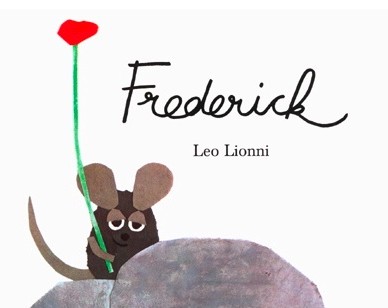
Not that I don’t think visual artists transfigure experience in crucibles of their own—I don’t mean that at all, and perhaps my metaphor is running away from me. What I mean is, there can be an immediacy in drawing and painting—you see it, you sketch it, you have it—that is wholly unlike the way writing happens for me. I suppose the place I find immediacy in writing is right here, on the blog, where, as I’ve said, I try to write more rapidly, in what I’ve come to think of as a kind of mental freehand. And the thing I love about drawing, clumsy as my skills are, is that the words part of my mind is actually silenced for a time. I think drawing may be the only thing I do where that is the case. I think in words, I see them scrolling across the screen of my mind always, always—when you speak to me, I see the transcript of our conversation. While things are happening, I’m searching for the words to recount the experience—it happens automatically, I can’t not do it. I first became aware of it on a plane headed for Germany when I was fourteen years old. I was frustrated that I couldn’t just be IN that moment, living it—I was already writing it up in my head.
I remember once telling another writer friend, as she described a similar experience: Oh, you’re like me, you think in narrative. I don’t know what it’s like to live in a mind that doesn’t work this way—except for those brief flashes of silence that come while I’m sketching. And yet I’ll go years without drawing. My skills are elementary (I can go a bit beyond the stick figures I was joking about the other day, but not far) but I know that, like all skills, regular practice would improve them. And so (to come back to my point at last) I was charmed by Lisa Congdon’s determination to hone an aspect of her work by doggedly doing it every day for a year. It’s a simple and even obvious notion, but how rarely such persistence occurs to us! Or occurs in practice, even after we’ve made the resolution.
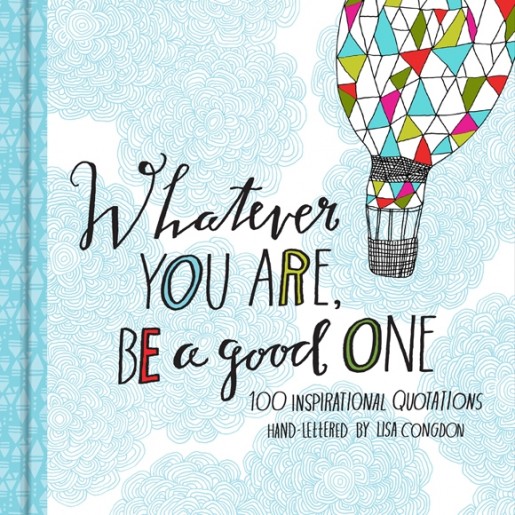
And then a few days ago Lisa interviewed another visual artist on her blog (delightfully named Today Is Going to Be Awesome). Jennifer Orkin Lewis is a freelance illustrator living in New York City, and her work is lovely, lovely. I was instantly smitten. I learned in Lisa’s interview that in April 2013, Jennifer decided to paint in her sketchbook every day for a month—which turned into painting in her sketchbook every day, period.
…I decided to do a painting a day for the month. I didn’t put any restrictions on myself and I ended up spending hours each day on them. I finished out the month, but it was stressful. In May I did it again but my rules were that I would limit it to 1 hour and I would only paint food. I finished that challenge as well but I felt too tied down to that theme and I didn’t experiment enough. I picked up the sketchbook I’m using now last October and I started painting in it. Something clicked and I really liked how the paint went onto the paper, its size, the fact that it wasn’t a gorgeous sketchbook. I kept painting in it so when January came it just flowed that this would be my daily project. I decided to post them all on Instagram to hold myself accountable to painting everyday.
When I went to Jennifer’s Instagram account (@augustwren), I was blown away. I think what I like best is that she posts a snapshot of the day’s painting alongside the paints and brushes she used to make it.
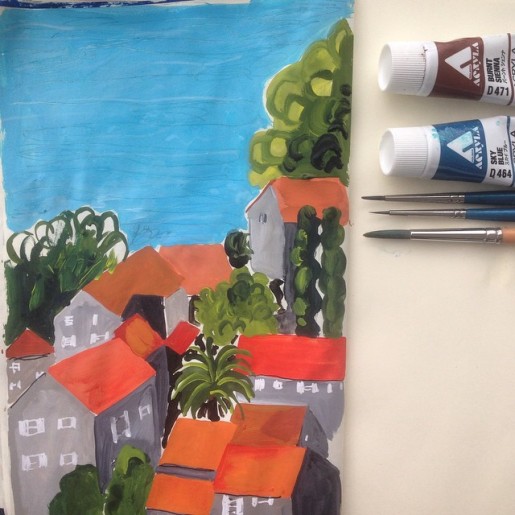
Kotor Montenegro by Jennifer Orkin Lewis. Image source: Instagram.
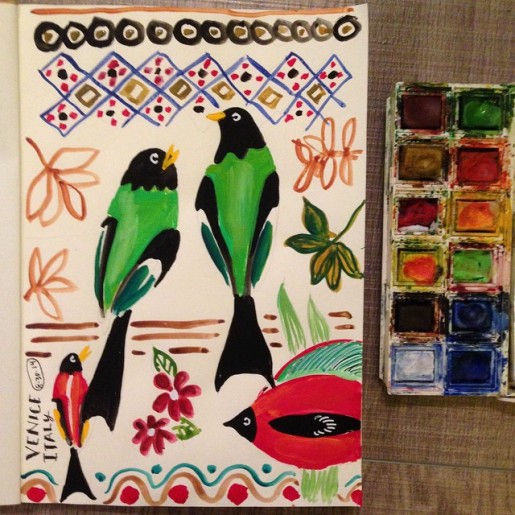
“I’m in Venice, these are some things I saw in shop windows.” Image source: Instagram.
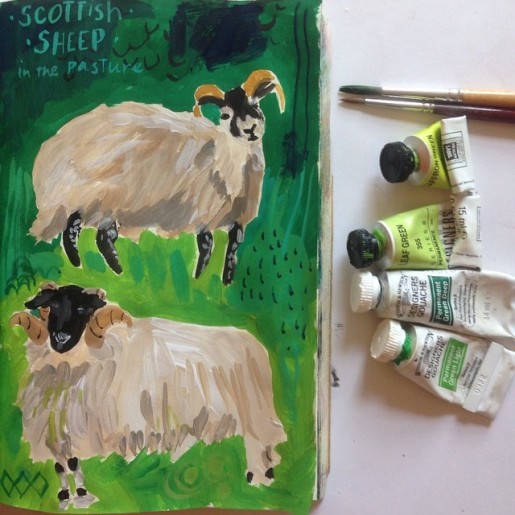
Scottish Sheep by Jennifer Orkin Lewis. Image source: Instagram.
“I’ve never really thought of myself as particularly disciplined, so I have surprised myself. I have loads of 1/2 finished sketchbooks on my shelves. A great result from the practice is I now have hundreds of pages of personal reference material. I’ve gone into it to look for color combinations for projects, for the shape of a flower, a technique.”
Please do click through to read the whole interview—it’s fascinating. Jennifer now works on these paintings for 30 minutes each. 30 minutes a day for over a year. She posts the finished pieces on her website, and the range is quite breathtaking.
The obvious conclusion to this post is a resolution to work in my art journal every day for a year, but do you know, I’m terrified to make such an avowal? I always feel like announcing a plan on the blog is a surefire way to stall it. 🙂 So no public declarations. Just a tiny, quiet—resolve is too binding a word. A notion. A hope. Last night after the boys were in bed, while Scott and the girls were watching a movie, Rilla and I worked in our journals. We used the Lisa Congdon piece at the top of this page as our inspiration. I’ve got Lisa’s 20 Ways to Draw a Tulip book and right now I’m in the copying stage, just trying to improve my own command of line. Got a long way to go. I added a fern to my sketch, though, figured it out all by myself using photo reference, and I’m pleased as punch with it (while simultaneously nitpicking its flaws). My writerly affection for circular structure demands its inclusion at the end of this post, but you that terrifies me too! Well, I once posted a story I wrote when I was five years old. My mother saved it for me and now I look at the fledging handwriting and nonsensical dialogue (“We will have to take care of it. If we don’t it will die.” “OK. Let’s go to the store and buy a big Ice-Cream.”) with real affection. Maybe in a year or ten I can feel the same way about this.
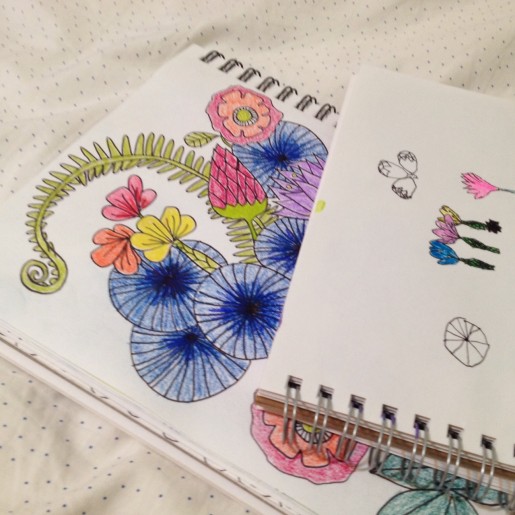
A different kind of copywork. Rilla likes to work in miniature and I like to eat up the page.






































